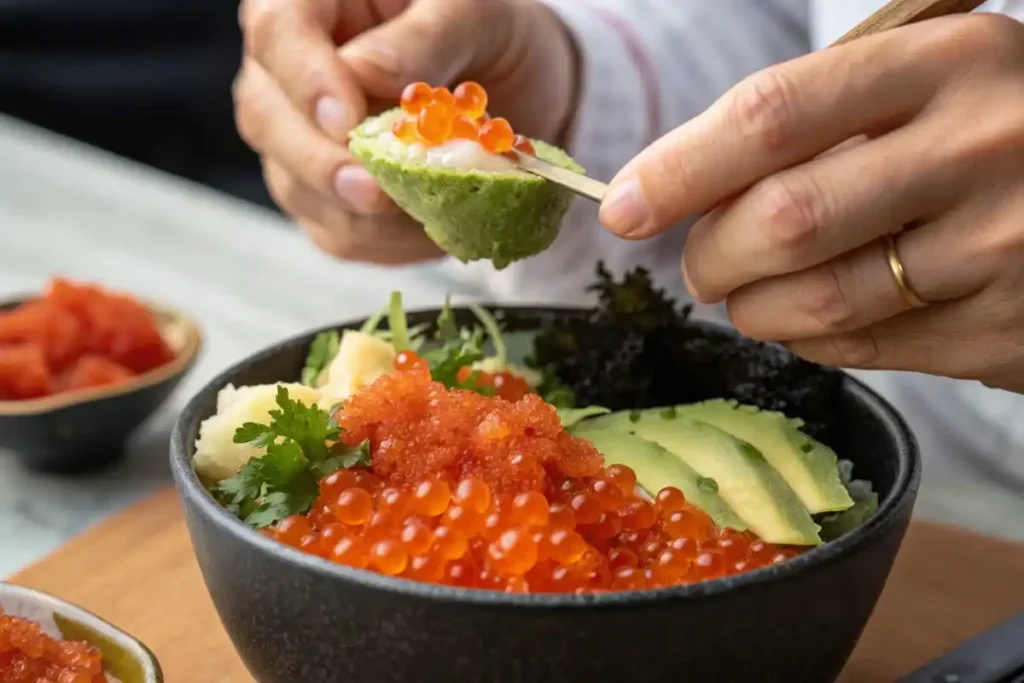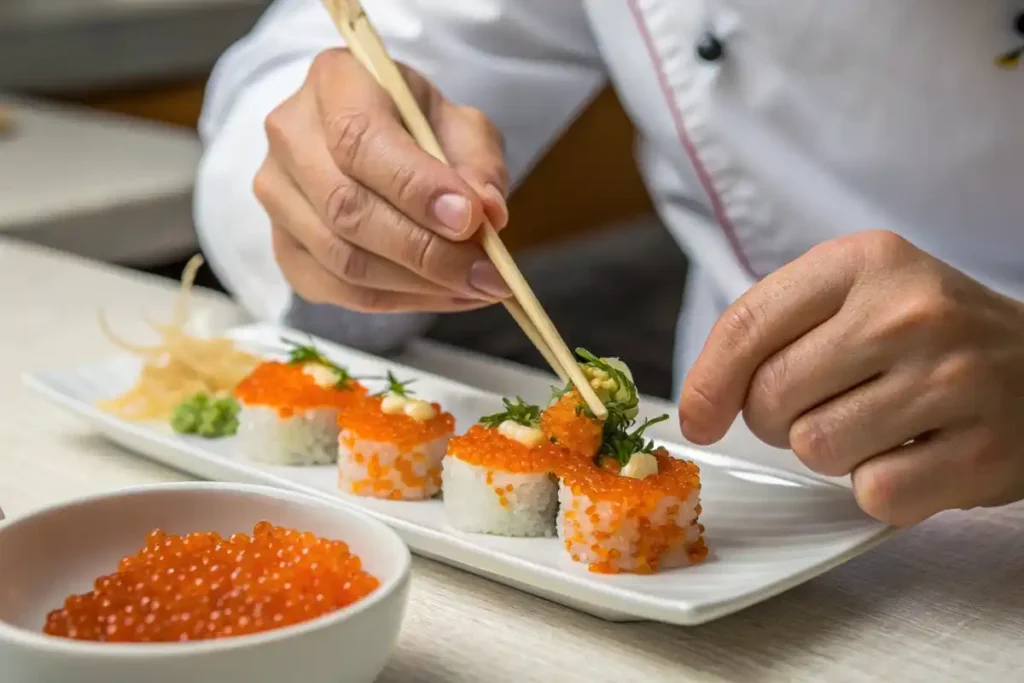Tobiko, or flying fish roe, is a popular ingredient in sushi and other dishes. This guide will explore where to buy tobiko, including local grocery stores and online retailers. We’ll also discuss the different types of tobiko, how to choose quality products, and tips for cooking and storing this delicious seafood.
Table of contents
1. Understanding Tobiko
What is Tobiko?
Tobiko is the Japanese term for flying fish roe, often used as a garnish in sushi. These tiny, colorful eggs add a delightful crunch and a burst of flavor to various dishes. Tobiko is typically bright orange, but it can also be found in green (wasabi-flavored), red, and black varieties. The unique taste of tobiko is slightly sweet and salty, making it a favorite among sushi lovers. It’s not just a pretty topping; it also provides nutritional benefits, including protein and omega-3 fatty acids, making it a great addition to your diet.
Types of Tobiko Available
When it comes to tobiko, variety is the spice of life! The most common types include orange, green (wasabi), and red tobiko. Orange tobiko is the classic choice, known for its mild flavor and crunchy texture. Green tobiko, infused with wasabi, adds a spicy kick, perfect for those who enjoy a bit of heat. Red tobiko, often used in specialty sushi rolls, has a slightly different taste and is visually striking. Each type of tobiko can enhance your dishes in unique ways, so it’s worth trying them all to find your favorite!
Nutritional Benefits of Tobiko
Tobiko isn’t just delicious; it’s also packed with nutrients! These tiny fish eggs are a good source of protein, providing essential amino acids that support muscle growth and repair. Additionally, tobiko contains omega-3 fatty acids, which are known for their heart-healthy benefits. It’s also low in calories, making it a guilt-free addition to your meals. Plus, tobiko is rich in vitamins and minerals, including vitamin B12 and selenium, which are important for overall health. So, when you’re enjoying your sushi, you can feel good knowing you’re indulging in something nutritious!

2. Where to Purchase Tobiko
Local Grocery Stores
When searching for tobiko, local grocery stores can be a great starting point. Many larger supermarkets, especially those with a good seafood section, often carry tobiko. Look for it in the refrigerated section near sushi ingredients or seafood. Additionally, specialty Asian markets are excellent places to find a variety of tobiko options. These stores typically offer different flavors and colors, ensuring you have plenty of choices. If you’re unsure where to start, ask a store employee for assistance; they can guide you to the right aisle.
Online Retailers
If you prefer shopping from the comfort of your home, online retailers are a fantastic option for buying tobiko. Websites like Amazon offer a wide selection of tobiko products, including various flavors and brands. Moreover, specialty seafood sites like Intershell Seafood provide high-quality tobiko, often with detailed descriptions of their products. Whole Foods Market is another reliable source, known for its fresh and sustainable seafood options. Shopping online not only saves time but also allows you to compare prices and read reviews before making a purchase.
3. Choosing Quality Tobiko
Quality Indicators
When buying tobiko, it’s essential to know what to look for to ensure you’re getting a quality product. First, check the packaging for freshness dates; fresher tobiko will have a longer shelf life. Additionally, look for clear labeling that indicates the source of the fish roe. High-quality tobiko should have a vibrant color and a firm texture. If possible, try to sample the product before purchasing, as this can help you assess its flavor and crunchiness. Remember, quality tobiko enhances your dishes, so it’s worth taking the time to choose wisely.
Flavor Varieties
Tobiko comes in several flavor varieties, each offering a unique taste experience. The classic orange tobiko is mild and slightly sweet, making it a versatile choice for many dishes. If you’re looking for something with a kick, green tobiko infused with wasabi adds a spicy twist that pairs well with sushi. Red tobiko, often used in specialty rolls, has a slightly different flavor profile and can add a pop of color to your plate. Experimenting with these different flavors can elevate your culinary creations and impress your guests!
4. Pricing and Availability
Is Tobiko Expensive?
When considering where to buy tobiko, it’s important to understand the pricing. Generally, tobiko is not overly expensive, but prices can vary based on the type and quality. For instance, standard orange tobiko usually costs around $10 to $20 per container, depending on the brand and store. However, specialty flavors like wasabi or red tobiko may be priced higher due to their unique ingredients. Moreover, buying in bulk can often save you money, so if you plan to use tobiko frequently, consider purchasing larger quantities.
Seasonal Availability
Tobiko is available year-round, but its freshness can vary with the seasons. In warmer months, you might find fresher options as seafood is often more abundant. However, during colder months, sourcing quality tobiko can be more challenging. To ensure you’re getting the best product, check local markets and online retailers regularly. Additionally, some stores may have seasonal promotions or sales, so keep an eye out for those opportunities. Staying informed about availability can help you enjoy this delicious ingredient whenever you want!

5. Cooking with Tobiko
How to Use Tobiko in Recipes
Tobiko is a versatile ingredient that can enhance many dishes. It’s most commonly used as a topping for sushi rolls, adding a delightful crunch and burst of flavor. However, you can also sprinkle it on salads, rice bowls, or even pasta for an unexpected twist. When using tobiko, consider pairing it with complementary flavors, such as avocado or spicy mayo, to create a balanced dish. Moreover, tobiko can be used in appetizers, like canapés, where it adds a touch of elegance and sophistication.
Substitutes for Tobiko
If you can’t find tobiko or prefer a different option, there are several substitutes you can use. One popular alternative is masago, which is capelin roe and has a similar texture and flavor. Another option is caviar, though it tends to be more expensive. For a vegetarian choice, consider using seaweed salad or even finely chopped vegetables to mimic the texture. While these substitutes may not replicate the exact taste of tobiko, they can still add a unique flair to your dishes.
6. Storing Tobiko
How to Properly Store Tobiko
Storing tobiko correctly is crucial to maintaining its freshness and flavor. If you’ve purchased tobiko, keep it in the refrigerator at a temperature below 40°F (4°C). It’s best to store it in its original packaging, as this helps preserve its quality. If you’ve opened the container, make sure to seal it tightly to prevent air exposure. Moreover, if you don’t plan to use it within a few days, consider freezing it. Just remember to transfer it to an airtight container to avoid freezer burn.
Signs of Spoilage
Knowing how to identify spoilage is essential for food safety. Fresh tobiko should have a bright color and a firm texture. If you notice any discoloration, off-putting smells, or a slimy texture, it’s best to discard it. Additionally, if the eggs have lost their crunchiness, that’s a sign they may have gone bad. Always trust your senses; if something seems off, it’s better to be safe than sorry. Proper storage and awareness of spoilage signs can help you enjoy tobiko at its best.
7. Frequently Asked Questions
What aisle is tobiko in?
When you’re on the hunt for tobiko, you’ll typically find it in the seafood aisle of your local grocery store. In larger supermarkets, it may be located near sushi ingredients or specialty items. If you’re visiting an Asian market, look for it in the refrigerated section alongside other fish roe products. However, if you’re having trouble locating it, don’t hesitate to ask a store employee for assistance; they can point you in the right direction.
Is tobiko expensive?
Tobiko is generally affordable, with prices ranging from $10 to $20 per container, depending on the type and brand. Standard orange tobiko is usually on the lower end of the price spectrum, while specialty flavors like wasabi or red tobiko may cost a bit more. Moreover, buying in bulk can save you money if you plan to use tobiko frequently. Overall, it’s a reasonably priced ingredient for enhancing your culinary creations.
What is a substitute for tobiko?
If you can’t find tobiko, there are several substitutes you can use. Masago, which is capelin roe, is a popular alternative that offers a similar texture and flavor. Another option is caviar, though it tends to be pricier. For a vegetarian choice, consider using seaweed salad or finely chopped vegetables to mimic the texture. While these substitutes may not replicate the exact taste of tobiko, they can still add a unique flair to your dishes.
Is tobiko actually fish eggs?
Yes, tobiko is indeed fish eggs, specifically from flying fish. These tiny, colorful eggs are a popular ingredient in sushi and other dishes. They are known for their unique texture and flavor, which can enhance various culinary creations. While some people may confuse tobiko with other types of roe, such as caviar or masago, each has its distinct characteristics. So, when you enjoy tobiko, you’re indulging in a delicious seafood delicacy!
Conclusion
In conclusion, knowing where can I buy tobiko is essential for any sushi lover or culinary enthusiast. You can find this delightful ingredient at local grocery stores, specialty Asian markets, and online retailers. Additionally, understanding how to store and identify quality tobiko ensures you enjoy its unique flavor and texture. If you’re looking for more seafood inspiration, check out our articles on what is tobiko sushi and tobiko recipes. With the right knowledge and resources, you can confidently incorporate tobiko into your meals and impress your guests with its vibrant taste! Enjoy exploring the world of tobiko and its culinary possibilities!

